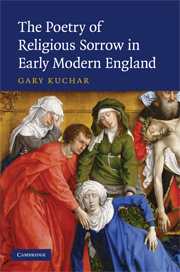Book contents
- Frontmatter
- Contents
- Acknowledgments
- Abbreviations and notes on texts
- Introduction: Of Sighs and Tears
- Chapter 1 The poetry of tears and the ghost of Robert Southwell in Shakespeare's Richard II and Milton's Paradise Lost
- Chapter 2 The poetry of tears and the metaphysics of grief: Richard Crashaw's “The Weeper”
- Chapter 3 The poetry of tears and the metaphysics of grief: Andrew Marvell's “Eyes and Tears”
- Chapter 4 Sad delight: Theology and Marian iconography in Aemilia Lanyer's Salve Deus Rex Judaeorum
- Chapter 5 Petrarchism and repentance in John Donne's Holy Sonnets
- Chapter 6 John Donne and the poetics of belatedness: Typology, trauma, and testimony in An Anatomy of the World
- Conclusion
- Index
- References
Chapter 2 - The poetry of tears and the metaphysics of grief: Richard Crashaw's “The Weeper”
Published online by Cambridge University Press: 22 September 2009
- Frontmatter
- Contents
- Acknowledgments
- Abbreviations and notes on texts
- Introduction: Of Sighs and Tears
- Chapter 1 The poetry of tears and the ghost of Robert Southwell in Shakespeare's Richard II and Milton's Paradise Lost
- Chapter 2 The poetry of tears and the metaphysics of grief: Richard Crashaw's “The Weeper”
- Chapter 3 The poetry of tears and the metaphysics of grief: Andrew Marvell's “Eyes and Tears”
- Chapter 4 Sad delight: Theology and Marian iconography in Aemilia Lanyer's Salve Deus Rex Judaeorum
- Chapter 5 Petrarchism and repentance in John Donne's Holy Sonnets
- Chapter 6 John Donne and the poetics of belatedness: Typology, trauma, and testimony in An Anatomy of the World
- Conclusion
- Index
- References
Summary
While Milton and Shakespeare participated in the desacralization of Catholic tear poetry, Richard Crashaw sought to further its Counter-Reformation. His 1648 work, “The Weeper,” has long been recognized as developing the poetic conventions of Southwell's St Peters Complaint, Giambattista Marino's “La Maddalena di Tiziano,” and other poems in the Catholic tradition that were popular in both Laudian and Tridentine Counter-Reformations. What critics have not recognized, however, is that “The Weeper” participates in a literary agon over the theology of poetic tears: just as Milton's Paradise Lost inverts the conventions of the Ignatian “Exclamation of wonder,” so George Herbert's Calvinist poem “Grief” – to which “The Weeper” is a kind of Counter-Reformation response – parodies the Southwellian tradition by refuting its ability to express a genuinely contrite experience of godly sorrow. In “Grief,” Herbert disavows the formality of Catholic tear poetry as a means of conveying the authenticity of devout sorrow, thereby offering a Protestant critique of the genre. Crashaw responds to Herbert's Calvinist poem by translating “Grief” from the private, meditative context of solitary prayer and into the public, liturgical space of Eucharistic worship. In the process, “The Weeper” turns away from Herbert's Calvinist poetics, in which the medium is not the message, developing, in its place, a more deeply sacramental poetic predicated on the ideal of linguistic isomorphism – the Eucharistic conjoining of word and thing.
Crashaw's “The Weeper” also differs from Herbert's “Marie Magdalene” in revealing ways.
- Type
- Chapter
- Information
- The Poetry of Religious Sorrow in Early Modern England , pp. 77 - 98Publisher: Cambridge University PressPrint publication year: 2008



